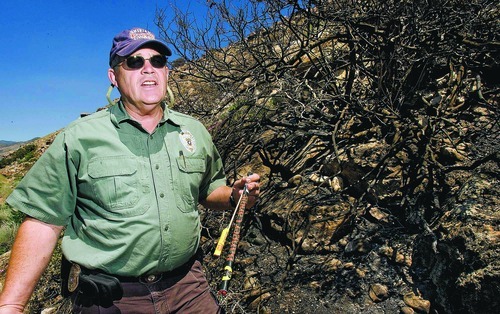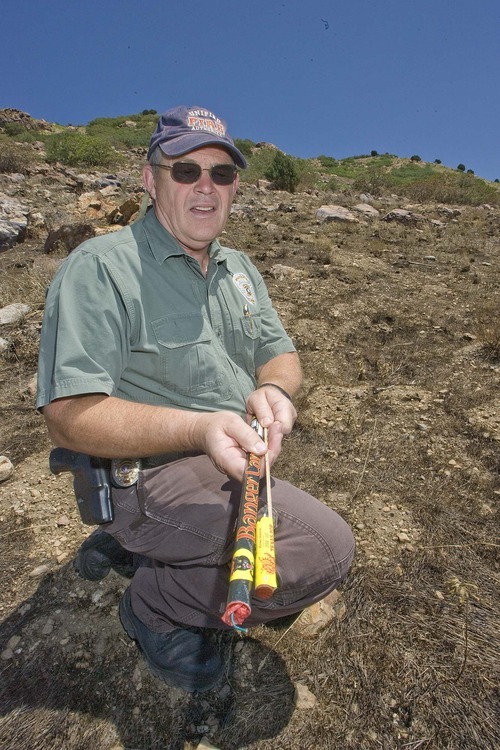This is an archived article that was published on sltrib.com in 2011, and information in the article may be outdated. It is provided only for personal research purposes and may not be reprinted.
Holladay • Ren Egbert paused for a moment before admitting it: Start a wildfire in Salt Lake County, and you probably won't be caught.
"I hate to say that publicly," said Egbert, an investigator for the Unified Fire Authority, "because I like the idiots to think we're going to catch them."
One of Egbert's colleagues, Jason Curry of the Utah Division of Forestry, Fire and State Lands, said he finds the fire starters in fewer than half of the human-caused blazes he investigates.
And even when the responsible party is found, the taxpayers are usually on the hook for a large portion, or all, of the cost of fighting that fire.
Lightning causes the majority of wildland fires in Utah, but there are still hundreds of human-caused fires each year. Even those fires that only span a few acres can burn structures and force homeowners to evacuate.
In a few cases, like the teenage boy last week who called 911 to report the fire he accidentally started with fireworks in Orem, the instigator reports the fire or confesses later. But Egbert and Curry say those cases are the exceptions.
The problem of finding fire starters begins with the very nature of wildfires. They often begin in isolated locations without witnesses.
"When you're investigating a wildfire as opposed to many other crimes, you're talking about a wide area," said Curry said. "Not only wide areas but also very remote."
Curry investigated the 2008 fire at the Nature Conservancy's Scott M. Matheson Wetlands Preserve in Moab. In that case, Curry found tire tracks indicating a truck had been in the preserve, but he was never able to find the driver. The blaze burned 450 of the preserve's 890 acres. Charring is still visible there.
The fire itself can destroy physical evidence. In a blaze that ignited July 6 near the Mount Olympus trail head, Egbert said firefighters found two spent Roman candle tubes and one spent aerial rocket. But the items were charred in the fire. Egbert doubted fingerprints could be recovered.
Egbert said he has more success investigating fires at homes or businesses, which typically sit in populated areas with witnesses and require more than a spark from a firework to ignite.
Accidental fires in Utah can be prosecuted under misdemeanor statutes for reckless burning or causing a disaster. Wildfires intentionally set can be prosecuted under the felony arson statutes.
Even when fire starters are identified, making them pay is another matter.
In the 2002 fire near the East Fork of the Bear River Scout Reservation, the federal government filed a civil action seeking $14 million, which it said was the actual cost of fighting the blaze, from the Boy Scouts and The Church of Jesus Christ of Latter-day Saints. The Boy Scouts in 2007 settled the case by agreeing to pay $6.5 million. The church was dismissed from the case. Scouts working toward a wilderness survival merit badge were suspected of igniting the blaze.
Statistics provided by the U.S. Attorney's Office for Utah show it has recovered $10.3 million in wildfire fighting money in five years. A spokeswoman for the office, Melodie Rydalch, said the office has staff assigned full time to pursue money from people, companies and organizations that ignite wildfires or their insurers.
By comparison, the Bureau of Land Management reported the cost of planting new grass seeds after the 2007 Milford Flat Fire was $17 million.
Who owns the land where the fire burns typically determines whether local, state or federal authorities pursue criminal charges or reimbursement. Mike Johnson, an attorney for the Utah Division of Forestry, Fire and State Lands, said that before suing for damages, the government has to determine whether the fire cost enough to pursue a court case, whether it can prove facts in court and whether the fire starters or an insurance company can pay.
The goal is to recover, or save, as much money as possible, Johnson said.
"If someone looks up and sees [a wildfire] burning, I guess what they should conclude is tax money is bound to get spent," Johnson said.
Washington County Attorney Brock Belnap said he can remember two cases in which he has prosecuted misdemeanor charges against people who started a wildfire on county-controlled land and asked them to pay restitution as part of their sentences. But Belnap believes the defendants paid just a portion of the true cost of fighting the fire. Belnap wasn't even sure those defendants paid what the judge ordered in restitution.
"It's the traditional, very common problem with trying to get blood out of a turnip," Belnap said.
The fire at the Mount Olympus trail head burned 7 acres and never got closer than a few hundred yards to any homes. The hillside sits in a watershed and the popular trailhead is bound to be muddier than previous years when the snow melts and rain falls in the spring.
Egbert said he and his fellow investigators are waiting for a witness or culprit to come forward.
"There are no more leads to follow," Egbert said.
Twitter: @natecarlisle









